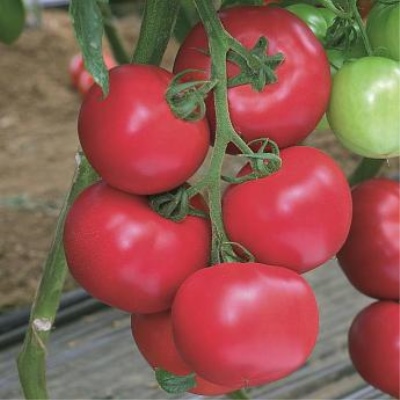
- Name synonyms: Fat Noble F1
- Category: hybrid
- Appointment: fresh consumption, for pickling and preserving
- Ripening period: mid-early
- Ripening time, days: 90-95
- Growing conditions: for open ground, for film greenhouses, for greenhouses
- Marketability: high
- Bush height, cm: 100-120
- Ripe fruit color: pink-raspberry
- Fruit shape: rounded flat
Hybrid tomato species, despite some of their shortcomings, remain consistently high in popularity. That is why each such type needs careful study. And the properties of the Fat Noble tomato are no exception.
Description of the variety
This tomato also has an official synonym - Fat Noble F1. Therefore, it is easy to guess that this is a classic hybrid culture. The plant can be cultivated both in a regular garden and in greenhouses under glass or under a film. The height of the bushes reaches 1.2 m. A crop with decent commercial characteristics grows on them.
The main qualities of the fruit
Having reached the necessary ripeness, the berries of the Noble Fat Man acquire a pink-crimson color. It is not difficult to distinguish them by this feature. The weight of a single berry varies from 0.2 to 0.25 kg. The round-flat shape of tomatoes is typical for this variety.
Taste characteristics
The crop can be used fresh. It is also good for canning. The pulp of the fruit is quite sugar-rich. Its fleshiness is also noted in the descriptions. Therefore, we can conclude that the result is at least not worse than that of other varieties.
Ripening and fruiting
The fat noble is a common mid-early culture. Between the discarding of green shoots and the appearance of developed fruits, an average of 90 to 95 days pass. Naturally, the weather often makes adjustments to this schedule. Fruits are usually harvested in July and August. In specific cases, the meteorological situation also affects here.
Yield
Suppliers of planting material report that the harvest can reach 4 kg from 1 bush. It is quite natural that in open and greenhouse plantings, the result will be different. The actual weather also plays an important role here, and what additional efforts are being made. Some sources specify that the collection can reach 8-12 kg from 1 bush.
The timing of planting seedlings and planting in the ground
The preparation of containers and the subsequent sowing of seeds in them is usually done in March. Depending on the weather conditions, landings are made in May or June. In this case, you will have to pay attention to the readiness of the plants themselves, and to the degree of heating of the soil.

Growing tomato seedlings is an extremely important process, because it largely depends on whether the gardener can harvest at all. All aspects must be taken into account, from seedbed preparation to planting in the ground.
Landing scheme
No more than 3 plants are supposed to be planted per 1 m2. If they form into 1 stem, you can add 1 more bush. But it is impossible to plant more under any option, because this will mean a strong overload of land. The depth of the holes is usually 0.3 m.

Growing and caring
Stepson is not required for the Fat Noble. But the garter for his bushes is absolutely necessary. It is recommended to choose areas that are well lit and protected from the wind. After pepper, potatoes or eggplant, planting such a plant is hardly worth it. Treatment for protection against harmful effects is carried out using the usual methods for tomatoes.




A plant needs different micronutrients at each stage of growth. All fertilizers can be divided into two groups: mineral and organic. Folk remedies are often used: iodine, yeast, bird droppings, eggshells.
It is important to observe the rate and period of feeding. This also applies to folk remedies and organic fertilizers.


Resistant to adverse weather conditions
The official description insists that this tomato is suitable for stressful living conditions. Therefore, it can be used in rather serious negative situations. But you should not rely too much on natural protective properties. Protection from cold, wind and drought will play an important role. In many cases, such negative phenomena can be predicted in advance and action can be taken.
Review overview
In evaluations, farmers pay attention to the unpretentiousness of the variety. Agricultural technology is almost the same as for most tomatoes. The good preservation of the harvest taken from the branches is noted. Eating it in food is possible in various ways, and any option is quite worthy. It must be emphasized, however, that planting material is not always on sale, and not all gardeners manage to achieve a pleasant aroma and rich taste.

























































































